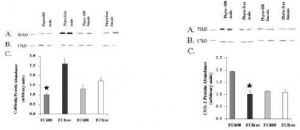Lilyan Yi Tian and Dr. Edwin Lephart, Zoology
Phytoestrogens are estrogen-like molecules found in many plants (that have a diphenolic, non-steroidal structure), such as, fruits, vegetables, legumes, whole-grain and especially soy products. These plant estrogen mimic the ability to selectively bind estrogen receptors and have recently received a great deal of investigative attention due to the potential protective effects against age-related diseases (e.g., cardiovascular disease and osteoporosis) as well as hormone-dependent cancers (i.e., breast and prostate cancer). At this time, however, little is known about the effects phytoestrogens have on the central nervous system (CNS).
Calbindin (CALB) is a calcium-binding protein that serves a potentially important role in both the development and function of the CNS. As the most abundant calcium-binding protein in neurons, calbindin apparently works to sequester/regulate intracellular calcium during genesis of the CNS. Also, it is thought to act as a potential neuroprotective factor against programmed cell death (apoptosis) that is associated with neurodegenerative diseases, such as, Parkinson’s and Huntington’s disease. [1-4]
The mitogen-inducible cyclooxygenase (COX-2) is an enzyme has been associated with CNS damage (via seizures and kainic-acid-induced apoptosis) and Alzheimer’s disease. In fact, COX-2 is strongly expressed in pyramidal neurons from Alzheimer’s patients. The cellular distribution of COX-2 is in neurons and not glial cells, however, the relative abundance of COX-2 is high in the frontal cortex.
Due to the importance of CALB and COX-2 in the CNS we will determine the influence of phytoestrogens on the expression of these molecules in brain tissue of adult rats. In order to determine this expression, we will quantify the levels of these molecules in the frontal cortex of adult rats fed with phytoestrogen diets.
The animals used in the present study were Sprague-Dawley female and male rats. Sprague-Dawley (50 day-old) female and male rats were obtained from Charles Rivers Lab (Wilmington, MA, USA) and were housed in a controlled environment. The animals were given free access to water and a phytoestrogen-rich or phytoestrogen-free diet.
At 80-90 days of age, the female rats (by diet treatments) were mated and randomly assigned to two treatment groups: 1) Phytoestrogen sterol-free diet (referred to hereafter as the Phyto-free diet) or, 2) the Phytoestrogen-containing diet (referred to hereafter as the Phyto-600 diet). The Phyto-free rat diet was obtained from Ziegler Bros. (Gardner, PA, USA); balanced and matched for equivalent percentage content of protein, carbohydrate, and fat to that of the commercially available Phyto-600 diet (Harlan- Teklad). The concentration and type(s) of phytoestrogens in the two diets were analyzed in duplicate by reverse-phase high pressure liquid chromatography (HPLC) using a 25 x 0.46 cm Aquapore (C8; particle size 7 μm) column under gradient elution conditions, with internal controls. The Phyto-600 diet contained a total of 600μg/g of phytoestrogens while the phytoestrogen content in the P-free diet was below the limits of HPLC detection.
After a life-long exposure on the diets, at approximately 120 days of age, the rats were sacrificed and at this time, blood and brain tissue samples were collected using landmark boundaries. The animals and methods of this study had been approved by the IACUC (Institute of Animal Care and Use Committee) at Brigham Young University.
Calbindin (CALB) and COX-2 levels in the frontal cortex tissue samples were determined by Western blot analysis. The data derived from the adult rats were tested by analysis of variance (ANOVA), followed by pairwise comparisons (via Neuman-Kuels analysis) to detect significant differences between the treatment groups (α = p < 0.05).
1. The CALB levels of animals fed the Phyto-600 diet were significantly decreased in male rats compared to animals fed the Phyto-free diet.
2. The COX-2 levels of animals fed the Phyto-600 diet were significantly increased in male rats compared to animals fed the Phyto-free diet.
These data suggest that phytoestrogen diets can alter the abundance of calcium-binding proteins as well as COX-2 expression.
This research will be presented at the Annual Meeting of Society for Neuroscience, Nov.10- 15, 2001, San Diego, CA; E. D. Lephart, T. W. West, L. Y. Tian, L. H. Bu, D. L. Simmons, H. Adlercreutz, T. D. Lund; Neurobehavioral effects of dietary soy phytoestrogens; Society of Neuroscience, Abstract. 27(2001)
References
- Enderlin, S, Norman, A. W. and Celio, M. R., Ontogeny of the calcium binding protein calbindin in the rat nervous system. Ann. Embryol., 177 (1987) 15-28.
- Iacopino, A.M. and Christakos, S., Corticosterone regulates calbindin-D28k mRNA and protein levels in rat hippocampus, J. Biol.Chem., 265(1990) 10177-10180.
- Iacopine, A. M., Quintero, E. M. and Miller, E. K., Calbindin-D28k potential neuroprotective protein, neurodegeneration, 3 (1994) 20
- Lephart, E.D., Watson, M.A., Jacobson,.N. A. and Rhees, R. W., Calbindin-D28k is regulated by adrenal steroids in hypothalamic tissue during prenatal development, Dev. Brain Res., 100(1997)117-12

